How to Create a Marketing Calendar
Managing your content and campaigns for your marketing team or agency? Learn step by step on how you can create your marketing calendars to manage your end to end marketing data and workflow effectively.

It is evident from reports that organized marketers are 674% more likely to achieve success in their endeavors. And do you know what is the best way to stay organized? Well, it's by leveraging a marketing calendar. Yes, you heard it right!
A marketing calendar can be a valuable tool for any business or agency aiming to plan, organize, and execute their marketing initiatives effectively. It acts as an all-inclusive solution that outlines the schedule of marketing activities, helping teams stay aligned, focused, and efficient in their efforts.
In this definitive guide, we will delve into the significance of a marketing calendar, the crucial elements to incorporate, and the step-by-step process in which you can create a marketing calendar.
So, let’s move further with our discussion:
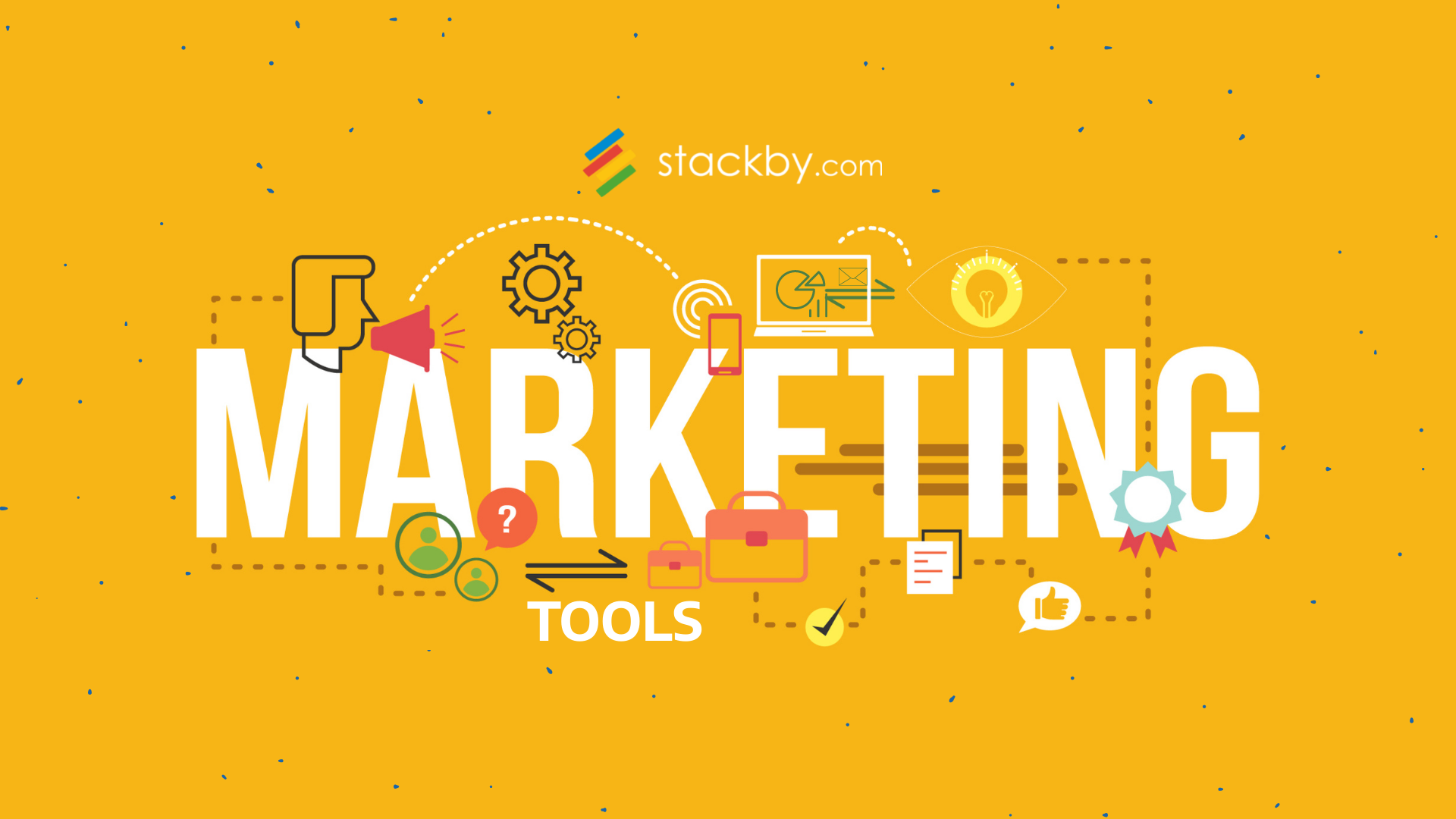
What is a Marketing Calendar?
A marketing calendar is a strategic roadmap that outlines your marketing activities over a specified period. It provides a comprehensive view of your upcoming campaigns, content releases, social media posts, and other promotional efforts.
Essentially, it serves as a guiding light that keeps your marketing team aligned, ensures consistency in communication, and maximizes the impact of your efforts.
Significance of a Marketing Calendar
- Efficient Planning and Execution: A marketing calendar helps you plan your campaigns and activities in advance. This proactive approach ensures you are well-prepared for launches, events, and promotions. As a result, it helps in reducing last-minute rushes and stress.
- Consistency and Brand Identity: Maintaining a consistent brand identity is crucial for building recognition and trust.
A marketing calendar lets you schedule content releases and create social media calendars or schedule posts at regular intervals. So, it facilitates maintaining a steady flow of engagement with your audience.
- Resource Allocation: With a marketing calendar, you can allocate resources – time, money, and personnel – more efficiently. You will have a clear overview of where each team member is involved and how much time they have for each task.
- Alignment and Collaboration: Everyone on your marketing team can access the same calendar, ensuring everyone is on the same page. It promotes collaboration, minimizes misunderstandings, and fosters a sense of unity.
- Adaptability: Markets can change quickly. A marketing calendar allows you to adjust your strategies and campaigns in response to market shifts, new opportunities, or unforeseen challenges.
Essential Elements to Incorporate into a Marketing Calendar
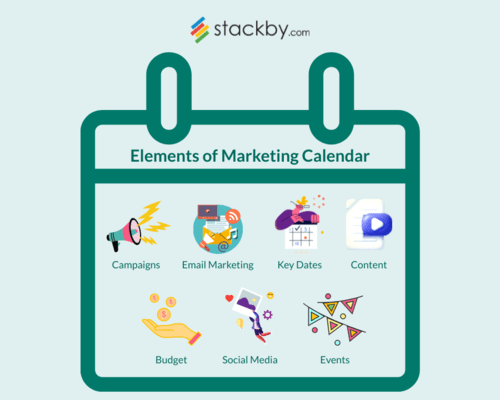
To create an editorial calendar or comprehensive marketing calendar, consider integrating the following elements:
- Campaigns: You should make sure to list all your marketing campaigns, including their objectives, target audience, messaging, and expected outcomes.
- Content Topics: It is crucial to outline the topics, formats, deadlines, and responsible team members for your blog posts, videos, infographics, and other content.
- Social Media: Plan and schedule your social media posts across platforms, including captions, hashtags, images, and links.
- Email Marketing: Make sure to detail your email marketing schedule, specifying the type of emails (promotional, informational, newsletters), send dates, and segments.
- Events: If your business participates in or hosts events, conferences, or webinars, include them in the calendar with relevant details.
- Budget: Allocate budgets to each campaign or activity, tracking expenses to ensure you stay within financial limits.
- Key Dates: One should incorporate important dates such as holidays, product launches, and industry events that could impact your marketing strategy.

Stackby's Marketing Calendar Template
Stackby's Marketing Calendar Template offers a streamlined approach to organizing your marketing efforts. The template includes two main tables: "Campaigns" and "Assets."
- Campaigns Table: This is where you will define your marketing campaigns. Each campaign can have its own set of attributes, such as objectives, dates, and more.
- Assets Table: Here, you can track the content and assets associated with each campaign. Whether it is a blog post, video, or graphic, you can specify its details, responsible team members, deadlines, and status.
Steps Involved in Building a Marketing Calendar in Stackby
Here's how you can create a content calendar or marketing calendar in Stackby. Just sign up on Stackby and log in to your dashboard.
Step 1: Add the Marketing Calendar Template to your Workspace
- Once you are logged in, you will be directed to your dashboard. Click on the "Templates" tab in the left sidebar.
- Browse the available templates or use the search bar to find the "Marketing Calendar" template. Click on it to open the template.
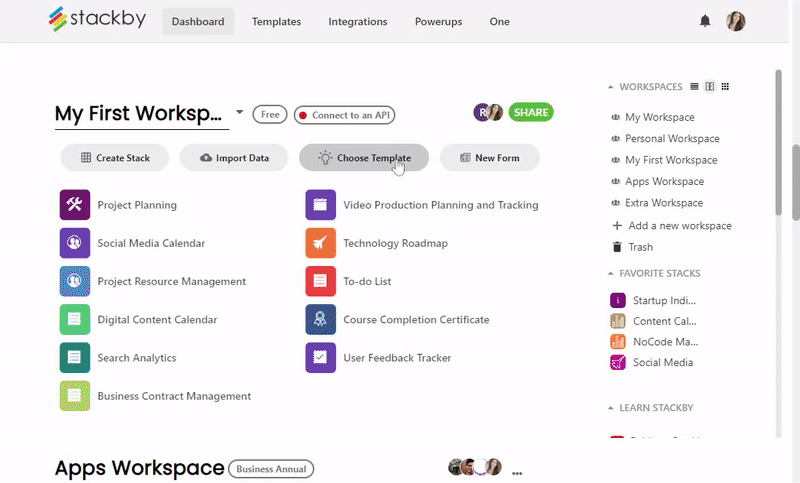
Step 2: Customize the Template
- The template will open, and you will see two main tables: "Campaigns" and "Assets."
- Start by customizing the template to fit your specific needs. You can rename tables, columns, and headers by clicking on the text and editing them.
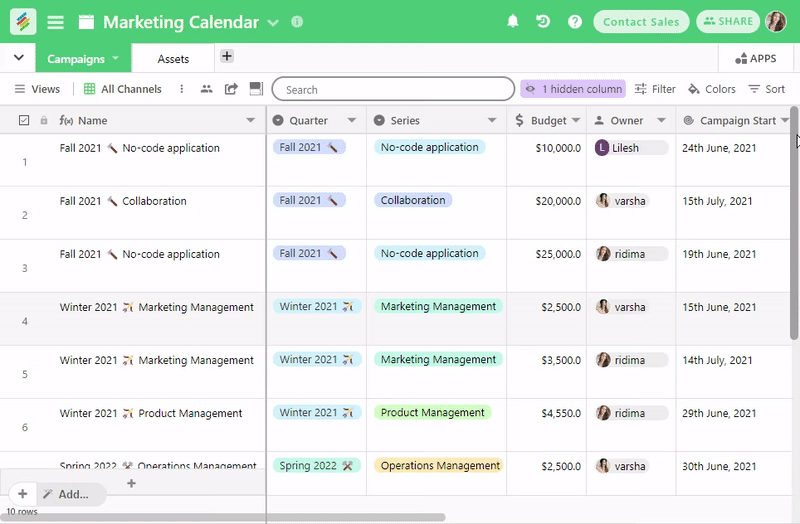
Step 3: Manage Campaigns
- In the "Campaigns" table, begin entering details about each marketing campaign you are planning.
- Create columns for campaign name, objectives, target audience, start and end dates, responsible team members, and other relevant information.
- Use additional columns to track each campaign's progress, metrics, and results.
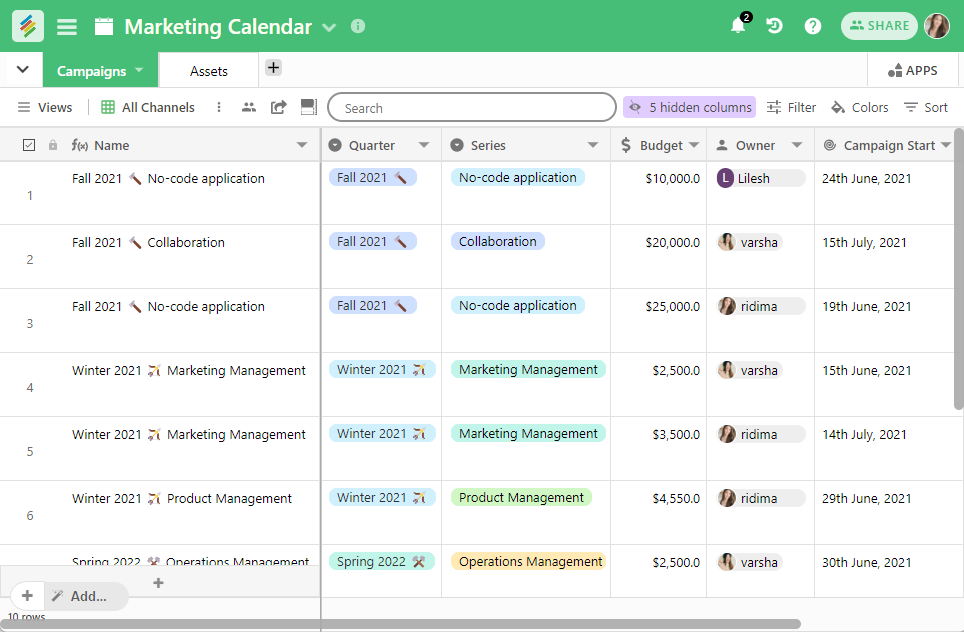
Step 4: Manage Content Creation
- Navigate to the "Assets" table. It is where you will track all the content pieces associated with your campaigns.
- Create columns to define the content type (blog post, video, infographic, etc.), the topic or title, the assigned creator, the due date, and the status (not started, in progress, completed, etc.).
- Add files and graphics in the attachment column.
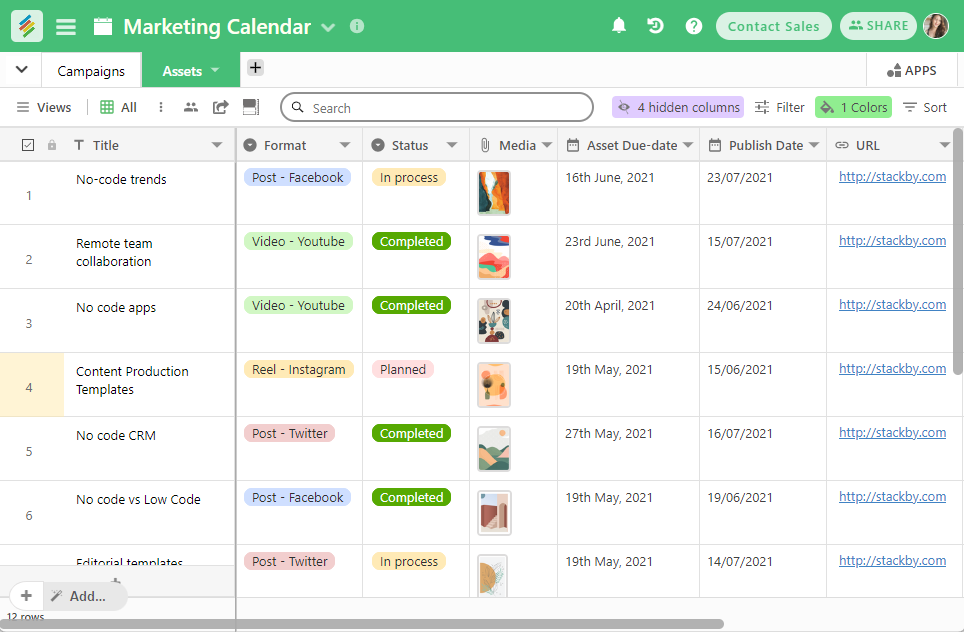
Step 5: Schedule Social Media Posts
- In the "Campaigns" table, link each campaign to specific social media posts in the "Assets" table. It will help you maintain a connection between your campaigns and corresponding social media content.
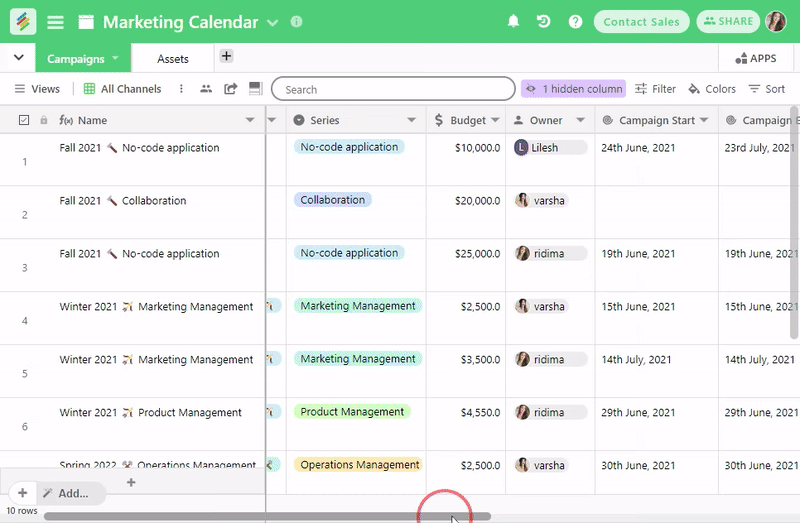
- You can utilize the calendar view in Stackby to schedule your social media posts. Select the date for each social media post. You can customize the color coding to differentiate between different types of posts or campaigns.

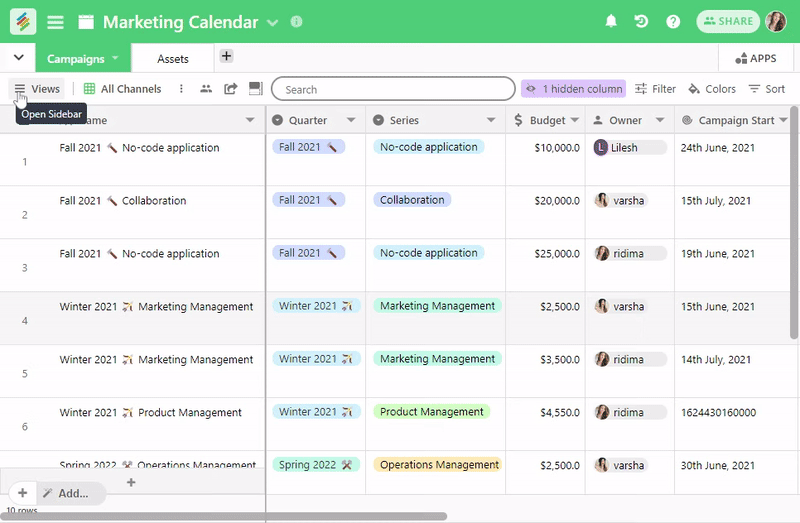
Step 6: Monitor Progress and Collaborate
- Use checklist to mark tasks as completed and set reminders to ensure important deadlines aren't missed.
- Encourage your team members to leave comments on tasks, assets, or campaigns to provide updates, feedback, or ask questions. This real-time collaboration helps keep everyone on the same page.
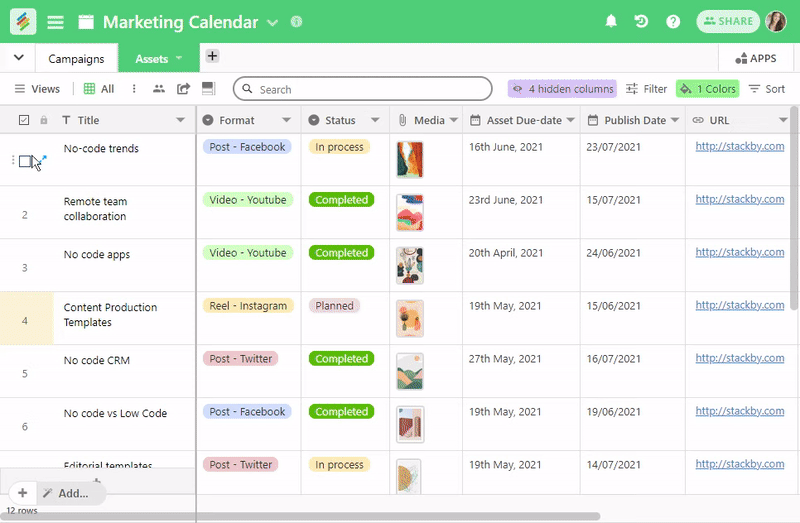
Step 7: Collect Stakeholder Requests
- To collect marketing requests from stakeholders, and set up custom forms.
- Create a form in the "Forms" tab where stakeholders can submit campaign ideas or requests. It ensures that new ideas are captured in an organized manner.
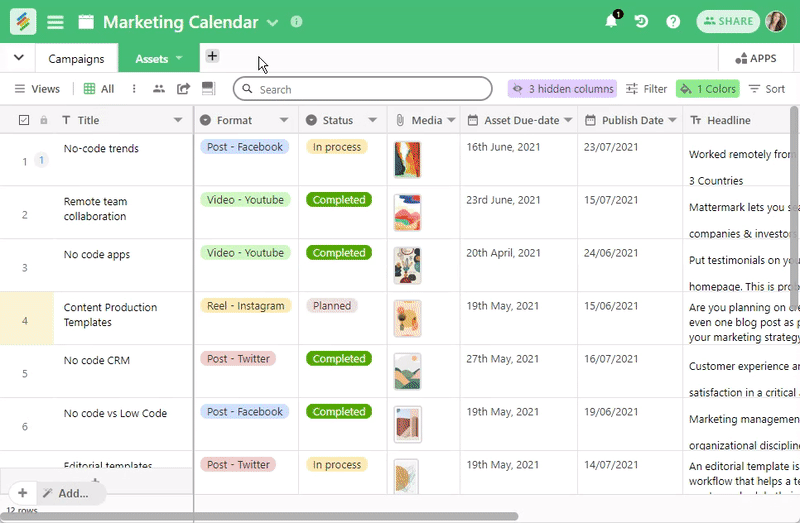
Step 8: Visualize the Data
- Utilize the Kanban view to see an overview of your campaigns and assets in a visual format. It can be beneficial for managing tasks and tracking progress.
- You can also view your assets in Gallery view.
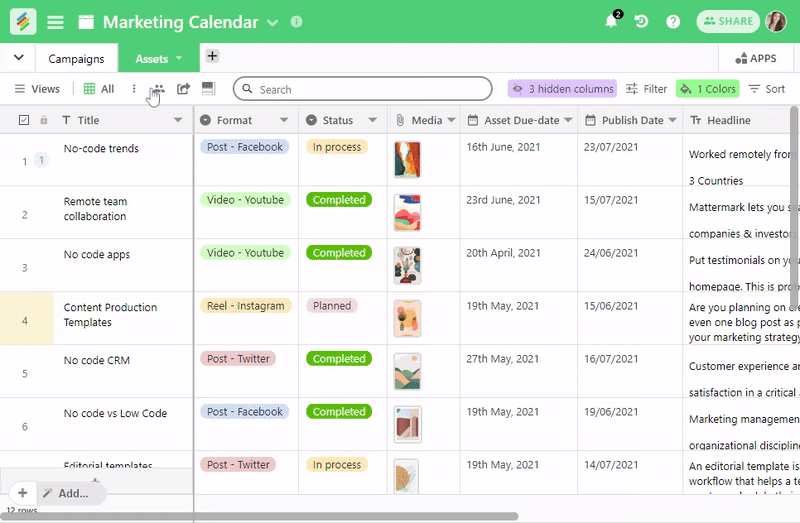
Step 9: Reporting and Analysis
- Create custom reports and dashboards to analyze the performance of your campaigns, content, and social media efforts.
- You can generate pivot tables, charts, and summary boxes based on the data you have entered in the "Campaigns" and "Assets" tables. This visual representation can provide insights into the effectiveness of your marketing initiatives.
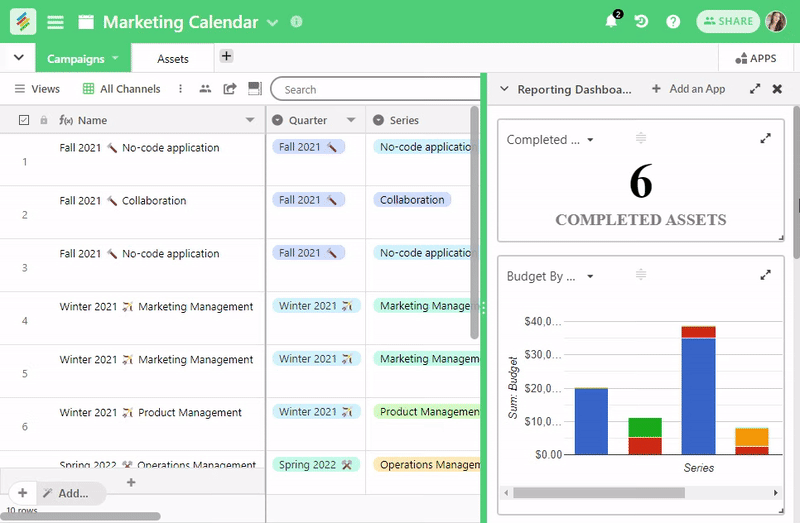

Video Guide
Make sure to check out this detailed video to get a clear idea about how to create a marketing calendar using the "Marketing Calendar" template by Stackby:
| Read more : Top Tools for Digital Marketing Agency
| Read more : Top 15 Free Marketing Calendar Templates
| Read more : 10 Free Event Planning Templates
| Read more : How to find the Right Marketing Plan Template
In a Nutshell
A well-structured marketing calendar is a cornerstone of successful marketing management. With Stackby's Marketing Calendar Template, you can efficiently organize your campaigns, streamline content creation, and foster collaboration within your team.
By integrating essential elements and following the outlined steps, you will be well-equipped to create a marketing calendar that enhances your strategic planning and execution. Sign up on Stackby for free and start creating your marketing calendar today.



![A Simple Guide on Workflow Management Software [Updated 2025]](/blog/content/images/size/w960/2021/12/work-management-blog.png)


